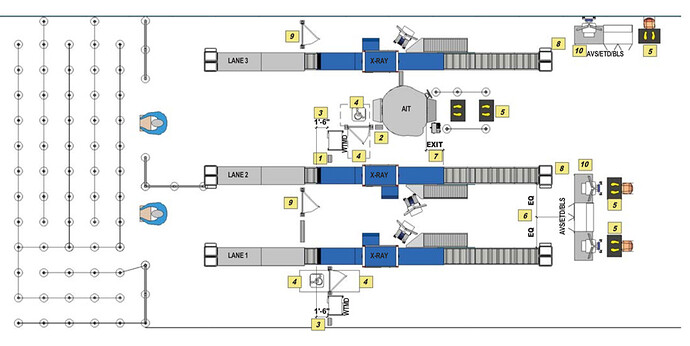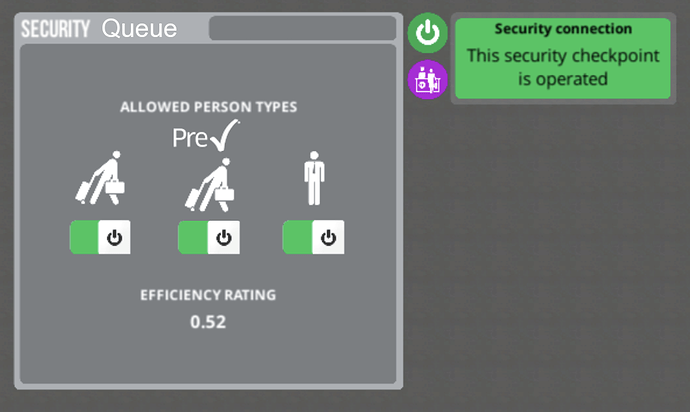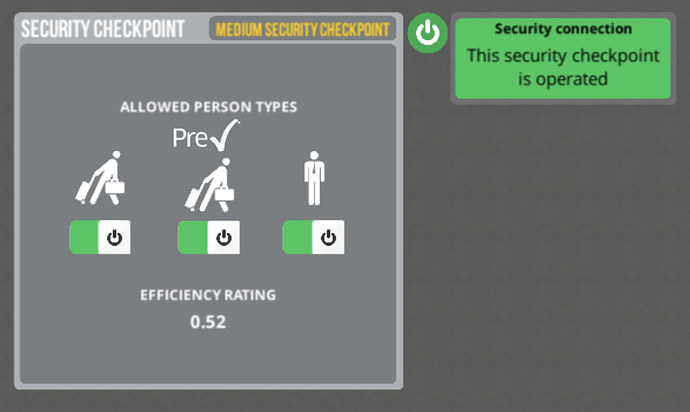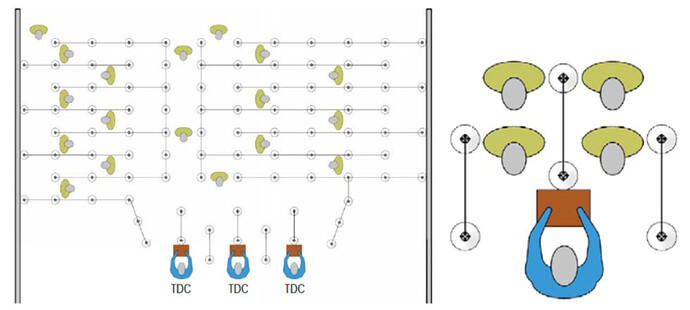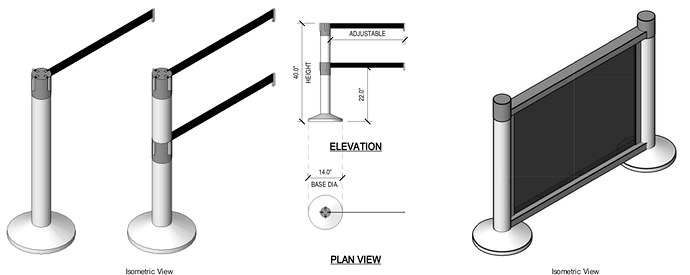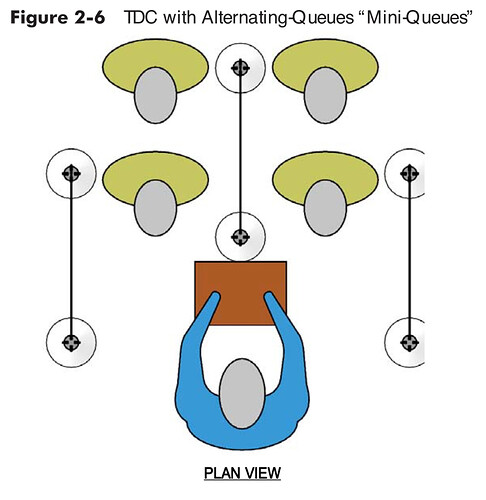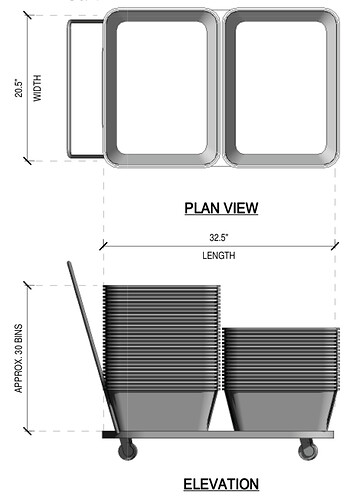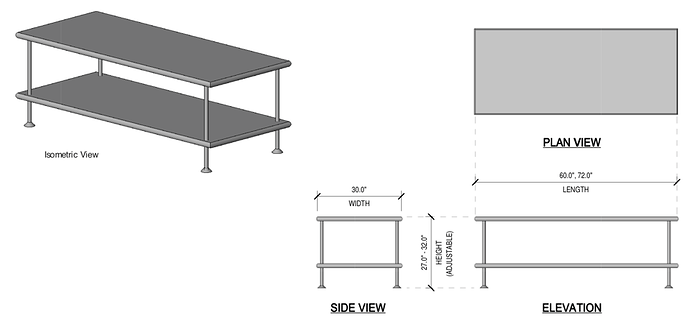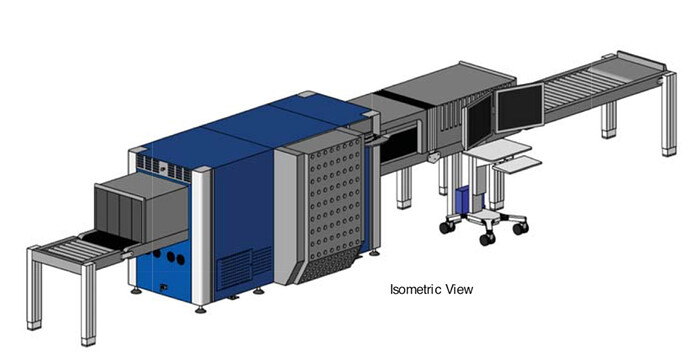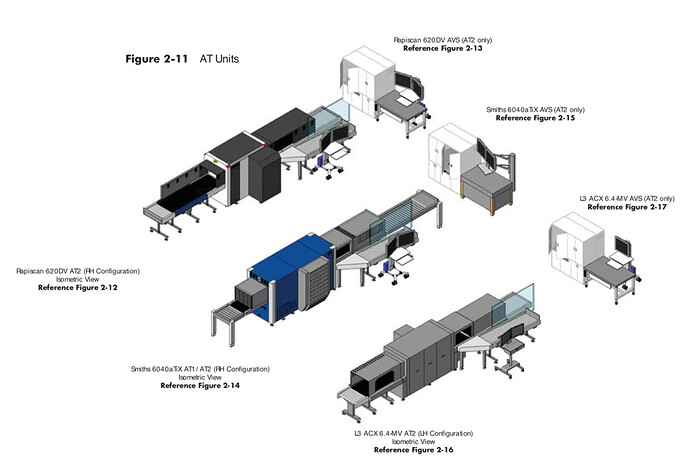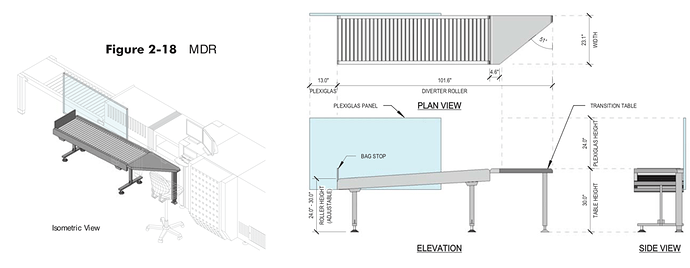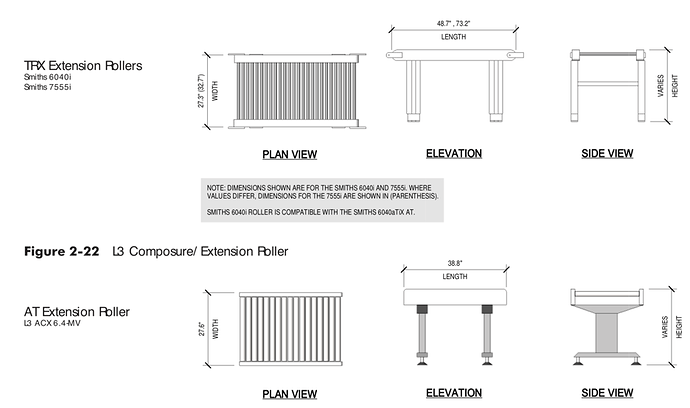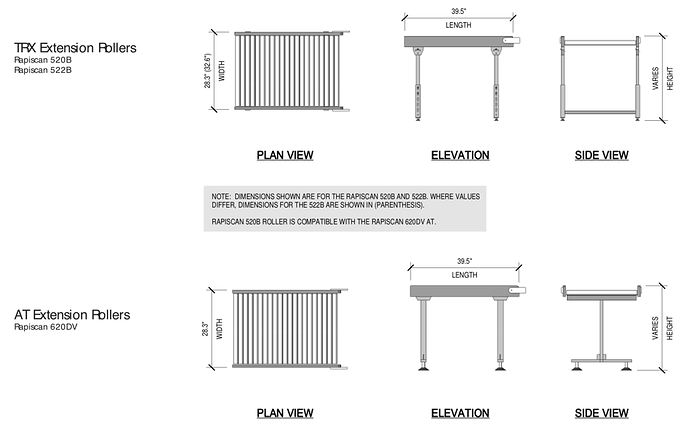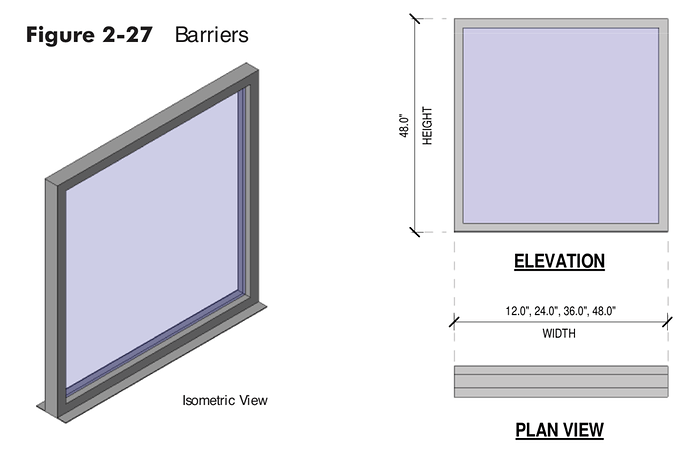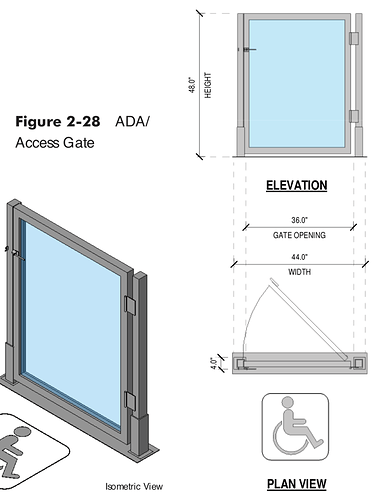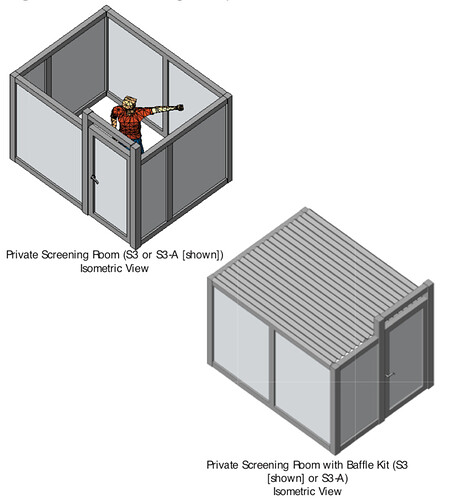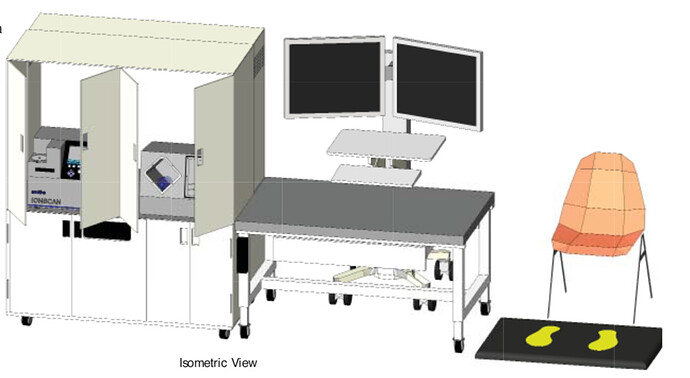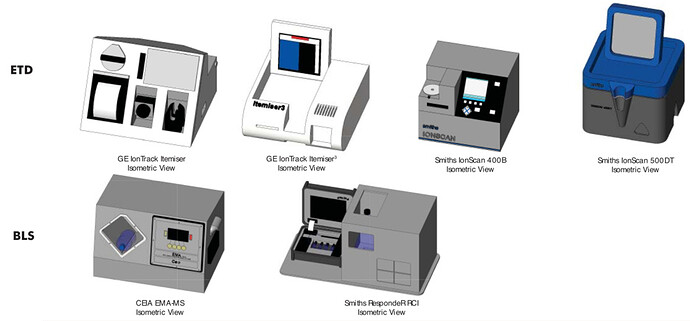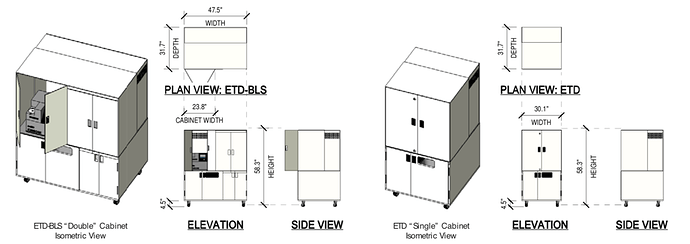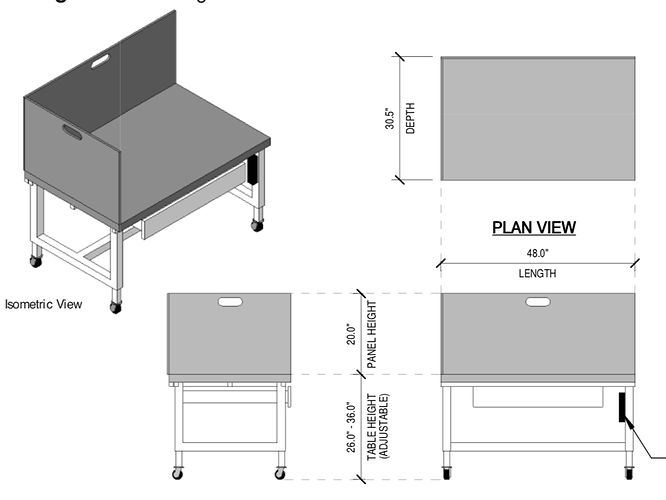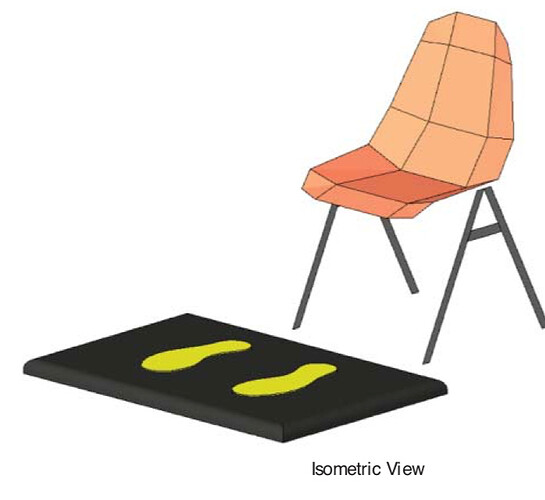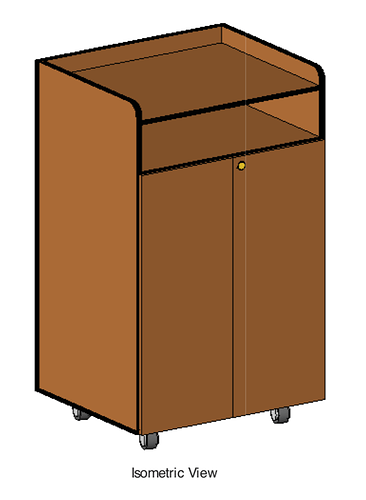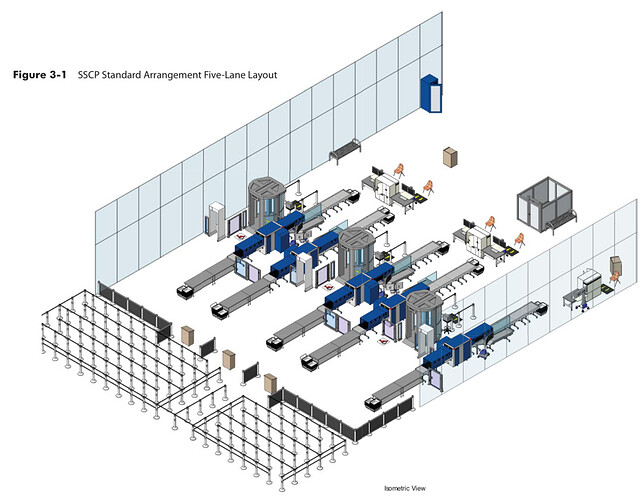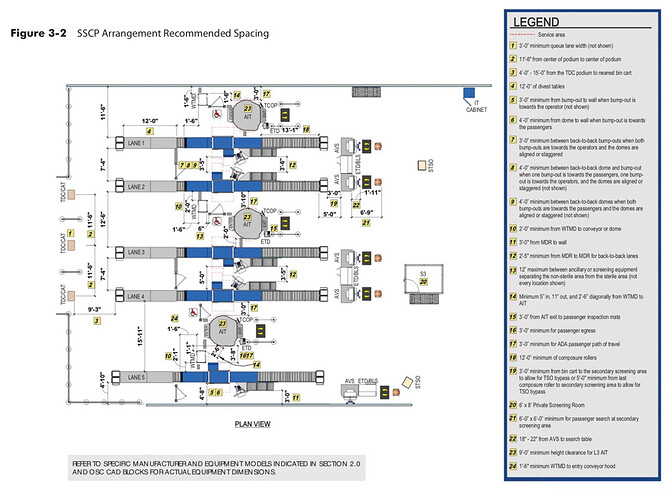| TABLE OF CONTENTS | Added | Link |
|---|---|---|
| CONSOLIDATED RENTAL CAR FACILITY | Added | Link |
| AIR CARGO/FREIGHT | Added | Link |
| CHECK-IN DESKS | - | |
| FIXED BASE OPERATORS (FBO) - GA/CHARTERS | Added | Link |
| FLIGHT SCHEDULER | - | |
| GROUND TRANSPORTATION & INTERNAL TRANSPORTATION | - | |
| ONE-WAY PATHS (ENTRANCE/EXITS) | - | |
| PREMIUM AND VIP SERVICES | - | |
| PASSPORT CONTROL/CUSTOMS | - | |
| ROADS | - | |
| RUNWAYS & TAXIWAYS | Added | Link |
| SECURITY CHECKPOINTS | Added | Link |
| SHORT-/LONG-TERM PASSENGER PARKING & STAFF PARKING | - | |
| STANDS | - | |
| AIR TRAFFIC CONTROL (ATC) | - | |
| UTILITIES & AIRPORT SUPPORT | - | |
| ZONING & CONNECTIONS | - |
SECURITY CHECKPOINTS
Checkpoint Design Guide Link (PDF)
PROPOSED DESIGN EXAMPLE
Using an example from the TSA Checkpoint Design Guide I came up with a new design for Security Checkpoints. They can either be implemented as a replacement to the current Security Checkpoints or they could be added as an upgrade (with an upgrade cost) like the Baggage System Upgrades.
There would be a couple changes with the new design.
-
- Grid dimensions would change to approximately 4-6 x 12-14 to accommodate the longer equipment support and extra staff needed. However due to them being longer and thinner there would not be a major space change. If anything, these new modular Checkpoints might take up less room than the current medium Checkpoints.
-
- More staff positions would be required (8 possible positions total or more?).
- a. Possible Security Staff Locations:
- i. (1) Entrance (TDC Officer) – checking passenger Identifications
- ii. (2) Each end of the X-Ray scanner
- iii. (1) At the X-Ray Scanner
- iv. (1) Escorting passengers through the WTMD (Walk Through Metal Detector)
- v. (1) Exit Podium
- vi. (1-2) Doing passenger bag and body room searches.
-
- Queue change from 1 queue line for every Checkpoint to 1 or more queue line per group. There would be a need for a queue line item added to the menu. The queue line would be built on the edge of the security zone, next to the checkpoints.
- a. Staff
- b. RBS/Premium Passenger – explained in queue section
- c. Regular/Economy Passenger
-
- 2 Signs added at the entrance of each queue line.
-
- Checkpoints no longer have queue lines attached to each one. Therefore, you can place the Checkpoints on a Secure Zone near the edge (with room between the que line exit and the checkpoint entrances for passengers and staff to walk. There will be two Checkpoints to pick from that mirror one another for creating multiple lines of checkpoints.
-
- There would be possible new equipment added to the Security Checkpoints and queues including:
- a. Security Directional and Instructional Signs at the entrance of each queue.
- b. Travel Document Checker (TDC), Credential Authentication Technology (CAT) and TDC officer at the TDC Podium - entrance of the new Security Checkpoints.
- c. Bin Cart and Bins at the start and end of each Checkpoint Scanning Line
- d. Divest Table
- e. Advance Imaging Technology (this would be a separate upgrade and item to place between a set of checkpoints).
- f. Solid barriers around the exterior of each checkpoint instead of stanchions.
- g. ADA/Access Gate
- h. Passenger Private Screening Room (PSR) – (another possible upgrade and separate item to place at the exit of 1 or more checkpoints)
- i. Secondary Screening Items including:
- i. ETD, BLS, Mobile Cabinet
- j. Bag search Table
- k. Passenger search position chair and Staff Desk
- l. Composure Bench – (possible item to add as an upgrade with the PSRs)
- m. STSO Podium with- STSO Officer
-
- There would also be an addition AIT (Advanced Imaging Technology) item that you could build between each line of Checkpoints for added security. This item is not shown in my example below but is explain In the Equipment list below. This could be offered as an addition upgrade as well like the Specific Baggage Bay Scanner Upgrades.
-
- There would be a toggle menu for both the Security Checkpoints and The Security Queue Lines to select which queue line and which checkpoint allows what group of passengers/staff. The toggle for the queue would only allow one toggle per que, however, you would be able to allow 1 or all 3 groups to pass through one checkpoint modular station.
-
- Developers would be able to add as many of the equipment listed below as space and coding permits or make any other adjustments as needed of course.
Here is a sample Security Checkpoint from the Checkpoint Design Guide Link (PDF)
Here is an example of how the new Checkpoints, queue lines would work and look in APCEO (without the extra equipment listed above and below). These checkpoints I created are equal to 4 x 12 on the grid = 48 squares instead of the current 8 x 8 medium checkpoint = 64 squares. So there is plenty of room to add in the extra equipment listed below. Another feature that would be nice to add is to add boarder around the exterior of all the Checkpoints with the Solid barriers equipment listed below (kinda like adding fencing in the game).
Here are examples of the new menus for the new Security Checkpoints and Queue lines. (note that the Checkpoint menu does not have a purple “build que” button.)
Here are examples of the three lines you would want to have at each security checkpoint area, however you would have free ability to design as you desire with the multiple options you would have. You could have a Security Checkpoint for only the two groups of passengers and a separate one for staff, the options of almost endless.
Checkpoint Flow Chart:
Example of real airport upgrade with this type of security design:
MODULAR SECURITY SCREENING CHECKPOINT (SSCP) EQUIPMENT ELEMENTS
MODULAR SECURITY SCREENING CHECKPOINT (SSCP) EQUIPMENT ELEMENTS
MODULAR SECURITY SCREENING CHECKPOINT (SSCP) EQUIPMENT ELEMENTS
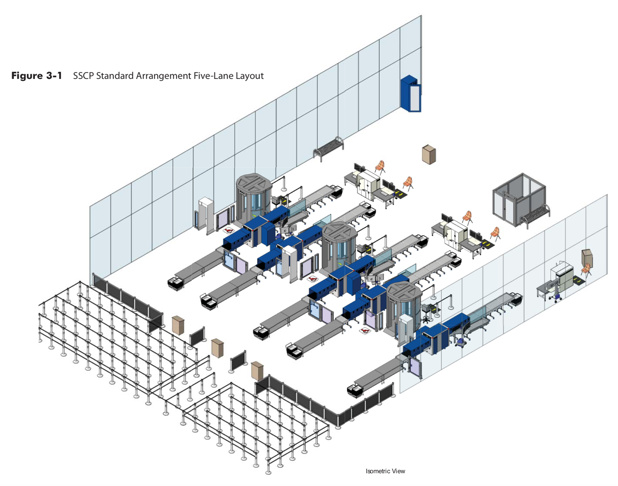
SECURITY INSTRUCTIONAL & DIRECTIONAL SIGNS
SECURITY INSTRUCTIONAL & DIRECTIONAL SIGNS
Directional Signs instruct passengers on where to go during the screening process, including providing direction to separate queue and screening lanes. The goal is to provide clear and concise directions so that passengers react quicker and overall time in the queue is minimized.
Instructional Signs provide passengers with instructions on the screening process. These signs advise passengers on how to properly divest of their possessions and how to place those items in the bins.
These Instructional and Directional signs could show up at the end and/or beginning of each queue when the cue Is built.
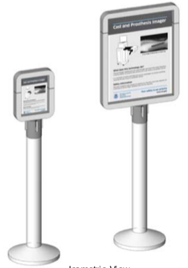
QUEUES
QUEUES
The queue is where passengers stand in line at the front of the checkpoint on the non-sterile side. The exclusive use of strap stanchions is inadequate to fully secure the checkpoint. Solid barrier stanchions are required along the boundary of TDC/CAT podium positions and the flanking side limits of the queue.
Here is where things take a major change from the current Security Checkpoints. Instead of having a queue for each security checkpoint, I purpose removing the queue from each individual checkpoint and adding a separate item to build. The “queue” item would show up somewhere in the Security Menu.
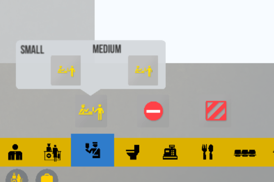
There would be 3 options for each queue line you add to a secure zone (near to the security checkpoints)
-
Staff/Employee – Priority over RBS/Premier and Regular Passenger/Economy queues.
-
RBS*/Premier – Priority over Economy Passenger queues.
-
Regular Passenger/Economy – No Priority
Risk Based Screening (RBS) is a method of defining a passenger’s credentials prior to the security screening process. Although only a few RBS methods are in place today, TSA and other organizations plan on expanding RBS in the future. TSAPre is an example of an RBS program which is currently expanding to airports across the country.
The queues would be placed along the edge of the “secure zone” and the entrance and build queue would expand out on the “non-secure zone” side with the queue exit on the “secure zone” side.
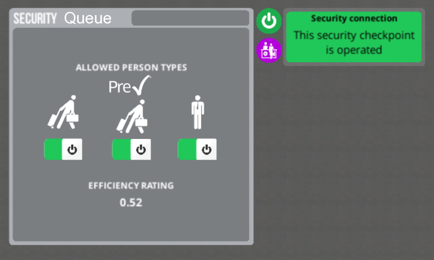
One queue at a time instead of 3 is another option. Then the user can add as many queue’s as they please or only stick with one. There would be a queue toggle menu as well. When you click on the queue. There would be 3 toggles that you could select. Only one toggle can be set for each queue and the other two toggles would grey out once a group is selected for that queue.
REASONS FOR ONLY ONE QUEUE LINE FOR EACH SECURITY STATION
This type of queue design/set-up is becoming more and more popular.
The time waiting in line remains constant whether there is one line or two, but movement is faster in one line. According to Richard Larson of MIT, considered to be an authority on lines, the psychology of queuing is more important than the statistics of the wait itself. Unoccupied time (standing still) feels longer than occupied time (moving). We prefer to keep moving.
This also keeps everyone in the queue in the same order they arrived at the queue. No longer will passengers get moved to the end of a line if they security checkpoint they when to closed down for whatever reasons.
PLUS, you only have to build one que and not 20 for the 20 security checkpoints you just built!!!
TRAVEL DOCUMENT CHECKER (TDC), CREDENTIAL AUTHENTICATION TECHNOLOGY (CAT) & TDC PODIUM
TRAVEL DOCUMENT CHECKER (TDC), CREDENTIAL AUTHENTICATION TECHNOLOGY (CAT) & TDC PODIUM
TSA checks passenger identification and boarding passes at the exit of the queue with enough space for passage occurring between the exit of the podium and the screening lanes. The TDC officer stands or sits at the TDC or CAT podium and verifies that all the necessary documents are in order. The CAT integrates different technologies that independently verify travel documents such as a driver’s license or passport. The CAT analyzes security features and barcodes on a passenger’s ID to identify fraudulent documents. The CAT compares the independently verified ID to validate the passenger’s identity and allow access to the screening checkpoint.
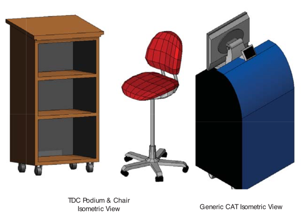
BIN CART
BIN CART
Bins are the gray containers located on a cart at the front and back of each checkpoint lane. Passengers use bins to divest themselves of their personal belongings such as purses, carry-on bags, backpacks, laptops, shoes, jackets, etc. Bin carts are similar to a hand cart or dolly that allows for the transport of a large number of bins without requiring excessive lifting or carrying by a TSA agent.
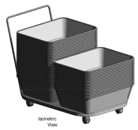
DIVEST TABLE
DIVEST TABLE
Divest tables are provided for passengers to stage their bins side- by-side so they can deposit their personal items into the bins. The divest table allows passengers to slide their bins to the infeed of the X-ray.
CARRY-ON BAG SCREENING
CARRY-ON BAG SCREENING
Carry-on bag screening is mandatory at an SSCP. It can be accomplished by deploying AT1 or AT2 equipment. Generally, this equipment has the following components:
- Loading Table/Entrance Roller
- Queuing Conveyor & Hood (Vendor Specific AT2 Only)
- Scanning Belt & Dome
- High Speed Conveyor (HSC) & Hood
- Extension Rollers
- Exit Roller with Bag Stop
- Manual Diverter Roller (MDR) (AT2 only)
- Alternate Viewing Station (AVS) (AT2 only)
ADVANCE TECHNOLOGY (AT) X-RAY UNITS
ADVANCE TECHNOLOGY (AT) X-RAY UNITS
The AT X-ray is the next generation of X-ray equipment that will replace the TRX. The AT X-ray is wider, longer, heavier, and draws more power than its TRX counterpart. Refer to Figure 2-11. This larger size improves the screening capability by capturing a bottom and side view of carry-on bags inside the dome and producing two high resolution images for TSA to review.
MANUAL DIVERTER ROLLER (MDR)
MANUAL DIVERTER ROLLER (MDR)
The MDR is a non-powered, gravity fed, stand-alone roller located on the operator side of any AT2 unit at the alarm bag cutout.
COMPOSURE/EXTENSION ROLLERS
COMPOSURE/EXTENSION ROLLERS
The TRX and AT units have a High-Speed Conveyor (HSC) covered by a tunnel located directly after the scanning belt. A carry-on bag arrives at the HSC after the bag has cleared the image review by the TSO. The HSC carries cleared bags to the composure/extension rollers where passengers can retrieve their personal items. These rollers are either called composure/extension rollers or exit rollers depending on the vendor and where they are installed on the TRX or AT.
WALK THROUGH METAL DETECTOR (WTMD)
WALK THROUGH METAL DETECTOR (WTMD)
The WTMD is used for passenger screening. It is an archway used to detect concealed metallic items and/or contraband.
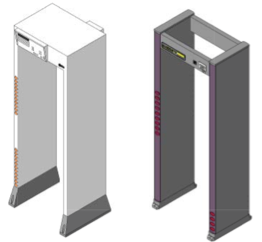
ADVANCE IMAGING TECHNOLOGY (AIT)
ADVANCE IMAGING TECHNOLOGY (AIT)
The Advanced Imaging Technology (AIT) provides an additional element of passenger screening by being able to detect a broad spectrum of materials concealed in or under a passenger’s clothing. The L3 ProVision portal uses millimeter wave imaging technology, similar to the type of waves a cell phone emits, to generate clear views of the items in question.
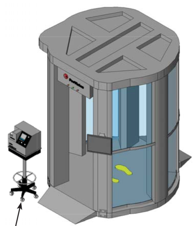
BARRIERS
BARRIERS
In order to prevent passengers and items from passing into the sterile area from the non-sterile area without being screened, barriers must be installed to close all gaps exceeding 12” across the front width or façade of the checkpoint. All barriers must be flush with the floor and be at least 48” above finished floor (AFF). Barriers must be rigid enough to prevent vibrations that could interfere with the WTMD and must be self-supporting to reduce any potential hazard to passengers and personnel at the checkpoint.
ADA/ACCESS GATE
ADA/ACCESS GATE
The ADA gate on the passenger side is part of the line that separates the non-sterile area from the sterile area. The ADA gate allows passengers that cannot otherwise traverse the WTMD or AIT to reach the sterile area. The ADA gate is typically used by wheelchair passengers, passengers requiring special assistance, or passengers with pacemakers.
PASSENGER INSPECTION PRIVATE SCREENING ROOM (PSR)
PASSENGER INSPECTION PRIVATE SCREENING ROOM (PSR)
Passenger inspection can occur at the screening lanes, at the secondary screening area, or in a private room at or near the checkpoint.
SECONDARY SCREENING
SECONDARY SCREENING
Secondary screening is additional screening that may be required for passengers and their bags when they alarm primary screening equipment. It is an area that is approximately 3’-0” to 5’-0” from the end of the screening lanes in order to minimize travel time and the distance that TSOs have to carry bags. Secondary screening is typically located in the “dead” operator space on back-to-back lanes or at the end of the lane for odd numbered lanes. This area should be clear of exiting passengers. The secondary screening area typically consists of Explosive Trace Detection (ETD) unit, a Bottle Liquid Scanner (BLS), an AVS (previously discussed in Section 2.5), a Mobile Cabinet, a search table and a passenger search chair and mate.
EXPLOSIVE TRACE DETECTION (ETD) & BOTTLE LIQUID SCANNER (BLS)
EXPLOSIVE TRACE DETECTION (ETD) & BOTTLE LIQUID SCANNER (BLS)
ETD units are used to swab carry-on bags that have alarmed at the TRX, AT or AutoEDS. These units should be contained within a mobile cabinet but can sometimes be found sitting directly on a search table.
Portable Explosive Trace Detection (ETD) units on a movable stand can be located at the exit of the AIT to perform additional screening when there are excess ETD units on site. With the exception of Category X sites, TSA HQ OSC will not procure additional ETD units for this location. This can be on either side of the AIT exit depending on where the power/data is located
MOBILE CABINET
MOBILE CABINET
Mobile Security Cabinets provide a secure and vented storage area for secondary screening equipment. There are two mobile cabinets that should be used for secondary screening. The ETD Mobile Cabinet is common in the field today. It encloses the ETD and operational, testing, and maintenance supplies. The ETD-BLS Mobile Cabinet will enclose the ETD and BLS, as well as operational, testing, and maintenance supplies.
BAG SEARCH TABLE
BAG SEARCH TABLE
Bag search tables are used for target bag searches, ETD swabbing, and BLS testing. The stainless steel surface allows TSA to provide a clean, contaminant-free surface.
PASSENGER SEARCH POSITION
PASSENGER SEARCH POSITION
When a passenger’s body or bag alarms during primary screening, they are escorted to a passenger search position within the secondary screening area unless the passenger requests private screening. Passenger inspection at the secondary screening area consists of a 6’-0” by 6’-0” area that includes a passenger inspection chair and mat.
COMPOSURE BENCH
COMPOSURE BENCH
Egress seating at the checkpoint is used for passengers to sit down and compose themselves with their personal belongings after completing the screening process. The screening experience is greatly improved if passengers can sit down to put their shoes and jackets on. TSA provides composure benches approximately 14’-0” from an AIT depending on the equipment arrangement. This area is typically out of the main passenger flow.
STSO PODIUM
STSO PODIUM
The Supervisory Transportation Security Officer (STSO) should be positioned at a podium near the checkpoint exit. The STSO should be able to perform administrative duties while viewing and supervising the entire screening operation. The location should have an unobstructed view of the checkpoint.
